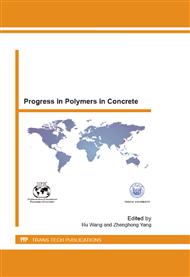[1]
United Nations, Kyoto Protocol to the United Nations Framework Convention on Climate Change, 1998.
DOI: 10.1163/9789004322714_cclc_2019-0165-620
Google Scholar
[2]
Van Gemert D., Contribution of concrete-polymer composites to sustainable construction and conservation procedures, International Journal Restoration of Buildings and Monuments, Vol. . 18 (2012), nr 3/4, 143-150.
DOI: 10.1515/rbm-2012-6520
Google Scholar
[3]
http://en.wikipedia.org/wiki/Kyoto_Protocol (24 October 2012)
Google Scholar
[4]
Czarnecki L., Kapron M., Van Gemert D., Sustainable Construction: Challeanges, Contribution of Polymers, Research Arena, Proceedings 7th ASPIC Asian Symposium on Polymers in Concrete, Istanbul 3-5 October 2012, 39-57.
Google Scholar
[5]
Europe 2001. Sustainable construction final report. European Working Group for Sustainable Construction.
Google Scholar
[6]
Research and Markets 2009. The cement industry in Europe and the Middle East: A Market/Technology Report. Materials Technology Publications, April 2008, p.290. http://www.researchandmarkets.com/reports/651928
Google Scholar
[7]
EuPC 2006.The European markets for plastic building products. European Plastics Convertors -– Building. http://www.plasticsconvertors.eu
Google Scholar
[8]
Hansen J., Sato M., Kharecha P., Beerling D., Berner R., Masson-Delmotte V, Pagani M., Raymo M., Royer D., Zachos C. 2008. Target Atmospheric CO2: Where should humanity aim? available through Cornell University Library at http://arxiv.org/abs/0804.1126
DOI: 10.2174/1874282300802010217
Google Scholar
[9]
Mehta P.K., Meryman H. 2009. Tools for reducing carbon emissions due to cement consumption. Structure Magazine, January 2009:, 11-15.
Google Scholar
[10]
Research and Markets 2009. , The cement industry in Europe and the Middleel East: A Market/ Technology Report. , Materials Technology Publications, April 2008, p.290. http://www.researchandmarkets.com/reports/651928
Google Scholar
[11]
Mehta P.K., Walters M.. 2008., Roadmap to a sustainable concrete construction industry. , The Construction Specifier., Vol. 61 (20081):) 48-57.
Google Scholar
[12]
Cembureau, http://www.cembureau.eu/about-cement/key-facts-figures, October 2012.
Google Scholar
[13]
Van Gemert D., Czarnecki L., Maultzsch M., Schorn H., Beeldens A., Lukowsky P., Knapen E. 2005. Cement Concrete and Concrete-Polymer Composites: two merging worlds. A report from 11th ICPIC Congress in Berlin, 2004. Journal of Cement and Concrete Composites,Vol 27: 926-933.
DOI: 10.1016/j.cemconcomp.2005.05.004
Google Scholar
[14]
Van Gemert D., Czarnecki L., Aguiar J., Ferreira M., Knapen E., Garbacz A. 2008. New trends in concrete-polymer composite materials and systems. International Journal for Restoration of Buildings and Monuments, Vol 14 (3):197-210.
DOI: 10.1515/rbm-2008-6217
Google Scholar
[15]
Knapen E., Van Gemert D., 2009. Cement hydration and microstructure formation in the presence of water-soluble polymers. , Cement and Concrete Research., Vol 39 (20091): 6-13.
DOI: 10.1016/j.cemconres.2008.10.003
Google Scholar
[16]
Ohama, Y. 1995. Handbook of polymer-modified concrete and mortars, Noyes Publications.
Google Scholar
[17]
Beeldens A., Van Gemert D., Schorn H., Ohama Y., Czarnecki L., 2005. From microstructure to macrostructure: an integrated model of structure formation in polymer modified concrete., RILEM Materials and Structures,. Vol 38 (2005) , nr 280:601-607.
DOI: 10.1007/bf02481591
Google Scholar
[18]
Ohama Y., Demura K., Endo T. 1992. Strength properties of epoxy-modified mortars without hardener. Proceedings of the 9th International Congress on the Chemistry of Cement, Vol. V, Performance and Durability of Concrete and Cement Systems, National Council for Cement and Building Materials, New Delhi, pp.512-516.
DOI: 10.1520/stp25548s
Google Scholar
[19]
Ohama Y. and , Van Gemert D. eds, Application of Titanium Dioxide Photocatalysis to Construction Materials, State-of-the-Art Report, RILEM TC 194-TDP, RILEM State-of-the-Art Reports Volume 5, ISBN 978-94-007-1296-6, e-ISBN 978-94-007-1297-3, DOI 10.1007/978-94-007-1297-3, Springer 2011.
DOI: 10.1007/978-94-007-1297-3
Google Scholar
[20]
Knapen E., Van Gemert D., Beeldens A., Photocatalytic activity of TiO2 in polymer modified mortar, Proceedings XIIth ICPIC Congress on Polymers in Concrete, Kangwon University, Chuncheon, Korea, September 2007, pp.309-316, ISBN89-960-0450-2
Google Scholar
[21]
Schueremans L., Van Gemert D., Giessler-Blank S., Durability of hydrophobic agents, used for chloride ingress resistance of concrete in marine environment, Proceedings XIIth ICPIC Congress on Polymers in Concrete, Kangwon University, Chuncheon, Korea, September 2007, pp.595-605.
Google Scholar
[22]
Van Gemert D., Cement concrete and concrete-polymer composites: two merging worlds Proceedings XIIth ICPIC Congress on Polymers in Concrete, Kangwon University, Chuncheon, Korea, September 2007, pp.3-15.
DOI: 10.1016/j.cemconcomp.2005.05.004
Google Scholar
[23]
Van Gemert D., Riga Natie Antwerpen- – Damage at Column K3/2, Triconsult D/00609/08, 2008.
Google Scholar


